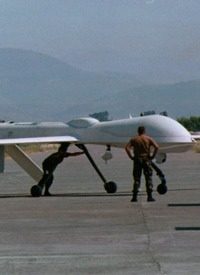
They’ve been used by U.S. troops in Iraq and Afghanistan to track, monitor, and kill the enemy. Now, if state and federal officials, including those in the Department of Homeland Security, have their way, pilotless military craft called unmanned aerial vehicles (UAV) — also known as “drones” — will soon be zipping around American airspace on a whole host of surveillance missions, and may even focus their gaze on U.S. citizens.
Currently drone aircraft are being used by U.S. Border Patrol agents to monitor areas near the Mexico border, and now Homeland Security and other agencies are pressuring the Federal Aviation Administration (FAA) to clear them to, among other duties, guard the U.S./Canada border and spot drug smuggling off U.S. coastlines. The capability of the drones to stay airborne for extended periods with no pilot offer an attractive incentive for their use in a variety of law-enforcement and domestic security functions. One of the drones, the Predator B, which is now in use on the Mexican border, can stay in flight for up to 20 hours without refueling, compared to a helicopter’s average two-hour flight time.
In addition to their use in a variety of federal law-enforcement and security functions, drones have been proposed for use by weather researchers tracking tornadoes and other storms, by energy companies who want to use them to monitor oil and gas pipelines, and by local and state police, who think they would come in handy to chase criminals and spy on suspects. Additionally, the U.S. Coast Guard has said that drones would be ideal for search-and-rescue operations.
While the FAA has been working for several years on plans to allow drones to fly in U.S. airspace, the department has been reluctant to give a go-ahead because of the potential for mid-air collisions in the nation’s busy skies.
Responding to charges from other federal agencies that his department is dragging its feet in allowing the domestic use of the unmanned craft, Hank Krakowski, FAA’s head of air-traffic operations, told the Associated Press, “I think industry and some of the operators are frustrated that we’re not moving fast enough, but safety is first.”
The biggest concern among FAA officials is the potential for the unmanned craft, which can be as small as a backpack or as large as a small commercial airliner, to collide with commercial passenger jets, cargo planes, or corporate aircraft that fly at high altitudes, or with helicopters, single engine planes, and even hot air balloons that fly from hundreds to a few thousand feet in the air. “This isn’t Afghanistan,” said Krakowski. “This isn’t Iraq. This is a part of the world that has a lot of light airplanes flying around, a lot of business jets.”
The FAA has also expressed its concern that those who remotely pilot the drones can lose communication with the craft, and that drones flying at lower altitudes away from major cities and airports may collide with planes in the area that are not required to have collision warning systems or even transponders. In these areas, simply seeing and avoiding another plane is the major accident prevention method.
In 2008, the National Transportation Safety Board convened a forum to discuss potential safety concerns following the crash of a Predator being used for border patrol in Arizona. An investigation determined that the pilot controlling the plane remotely had accidently turned off the drone’s fuel. Despite the continuing safety concerns, Texas officials—including Governor Rick Perry, Senators Kay Bailey Hutchison and John Cornyn, and Representative Henry Cuellar—have been on the leading edge of efforts to pressure the FAA to approve the increased use of drones on the furthest reaches of the Texas/Mexico border.
As the FAA teams up with Insitu, Inc., a Boeing subsidiary that manufactures drones, to conduct a long-term study aimed at addressing drone safety concerns, a report by the Government Accountability Office noted that no technology has yet been identified “as a suitable substitute for a person on board the aircraft in seeing and avoiding other aircraft.” The report stated that the communication and control links on drone craft “are vulnerable to unintentional or intentional radio interference that can lead to loss of control of an aircraft and an accident.” The report predicted that it could take another 20 years for all safety concerns to be fully addressed.
One issue that seems to have been overlooked in the debate over the domestic use of drones is the potential for government not only to use drones to protect borders and chase drug dealers, but to spy on whoever it wants whenever it wants — including law-abiding citizens. On March 29, 2006, Declan McCullagh reported on cnet.com: “In a scene that could have been inspired by the movie Minority Report, one North Carolina county is using a UAV equipped with low-light and infrared cameras to keep watch on its citizens. The aircraft has been dispatched to monitor gatherings of motorcycle riders at the Gaston County fairgrounds from just a few hundred feet in the air — close enough to identify faces — and many more uses … are planned.”
More recently, a United Press International story last January reported that drones developed by the British military are set to be used in the United Kingdom to monitor civilians from the sky. According to the report, police in Kent and Essex are planning to begin using drones by 2012 to track motorists, monitor protesters, and nab individuals involved in such criminal activities as illegal dumping.
While one might applaud the use of drones to protect America’s borders and even to stop sundry criminal activities, the idea that there are potentially “many more uses” for the unmanned airplanes has the stamp of government intrusion written all over it. In the near future, the craft you see zipping by overhead during the day, or blinking complacently in the sky by night, may give you pause to wonder whether or not you have covered all bases in complying lock-step with the ever-increasing burden of local, state, federal, and even international ordinances and laws.
If not, there may be a spy in the sky taking note.
Photo: AP Images



